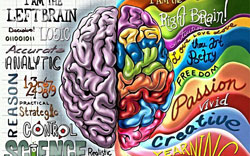What is the best way to learn? There are many different suggestions, options and theories out there that boast the most effective way to learn or study. Two most common are the “Left Brain, Right Brain Theory” and the “VARK Model.” But there is much controversy against these theories, so how are students supposed to learn? There has been a discovery of a process called “desired difficulty” that has shown very promising results when the students’ recollection of information was tested.
The Left Brain, Right Brain Theory has been around since the 1960’s when an epileptic had their brain split, separating the right and left hemisphere, severely limiting communications between the sides. People developed theories that one side of the brain was dominant and therefore your personality reflected the traits attributed to the dominant half. For example left brained people were viewed as logical, systematic and organized. While right brained people were seen as more artistic, intuitive and expressive. This theory really bloomed through time and people even adapted the idea into learning styles.
Hypothetically, left brained people would learn better through reading, taking notes and right brained people preferred lectures, visuals and hands-on experiences. However many recent studies have disproven this theory.
Dr. Jack Demarest, psychology professor, explained while each side of the brain does process certain information first, the brain shares the info with the other half almost instantly. With the whole theory disproven, the learning style becomes obsolete as well.
Some students, however, still believe in the right and left brain learning styles. “I think that there is some truth to this theory,” said Junior Lindsey Pieschl. “While there are different things the left and right hemispheres are known for, most processes are so intertwined it is hard to tell which side of the brain they come from.
The VARK model claims that every person learns best through a visual, auditory, reading or kinesthetic (hands on) approach. On the VARK official website there is a questionnaire that will determine which type of learner you are. There has not been much research done to prove the VARK’s efficiency. Even on the site there are some statistics 58 percent of people claimed that the VARK matched their learning style, 38 percent of people didn’t know and 4 percent had no match at all. Less than 60 percent may not seem very promising. The most effective method that has been proven shows that people don’t know when they are truly learning.
The process of “desirable difficulty” is actually not a learning theory that differs from person to person. It is a process of making information more difficult to learn, therefore highlighting it in your mind and making it more easily accessible. How does one do that? There are simple things people can do to make information stick in their memory better, for example, waiting until they almost completely forget information then re-testing themselves. It makes studying much more difficult but improves the recollection of the information. This can be achieved by studying two things one week, then switching to two completely new information and studying that. Later, they go back to studying the first thing. This is called interweaving studying.
David Payne, associate professor of psychology, explained that this method stimulates the hippocampus and the medial temporal lobe to store the information better. The increased difficulty makes that information stand out better than something you read in the paper, or on a billboard, it made you think. For example, you always remember one of your classes or teachers because they were the worst. The more difficult or unique memories keep in your mind more prominently than everyday mundane things. However most people don’t feel that they are learning as well because they aren’t as comfortable- people don’t like pushing themselves.
Psychologist Robert Bjork did an experiment on the spelling of words displayed on index cards. People who were shown the cards normally scored worse than people who were shown the cards upside down. This is because processing information that is upside down is unique and the brain latched on to that information and recalled the words dramatically better than the control group. Bjork and other researchers have conducted many similar studies and the results have been consistent. Schools have been just catching on to this idea and are starting to adapt courses to compliment the idea of desirable difficulty.
There may be preference of methods to learn so you don’t fall asleep, however in the end all brains end up processing information the same way. Almost all learning style theories have been disproved since their FAD in the ’80s. However, the desirable difficulty method is an effective way to help remember information- but might take some practice to fully use.
PHOTO TAKEN from hqscreen.com




